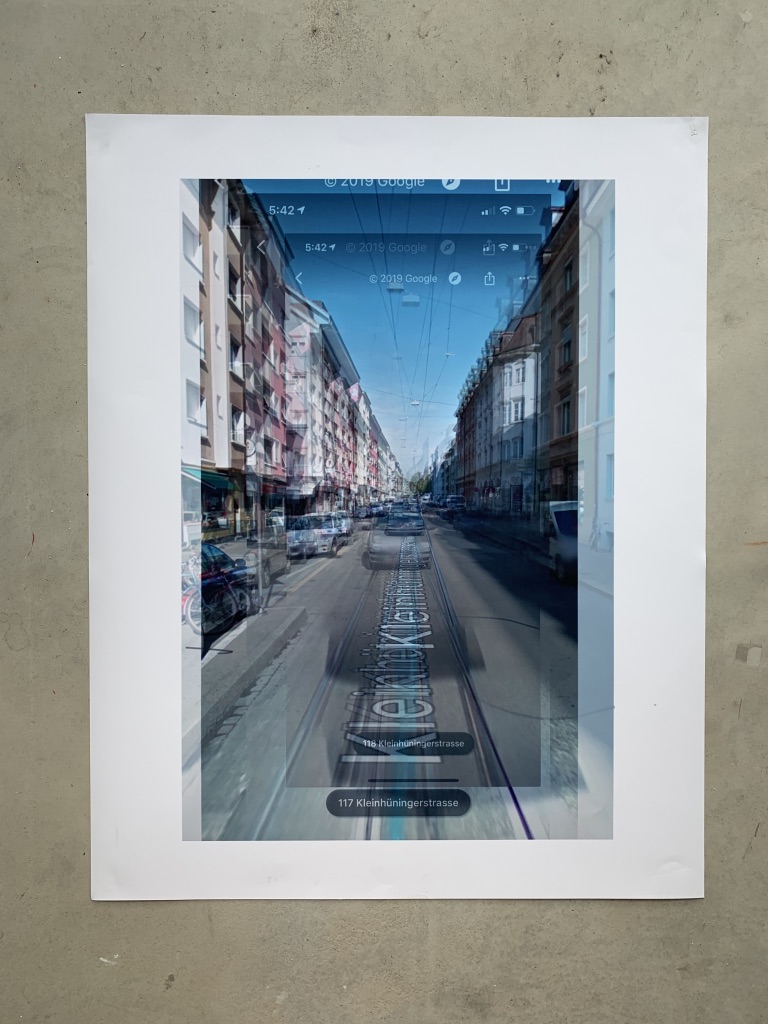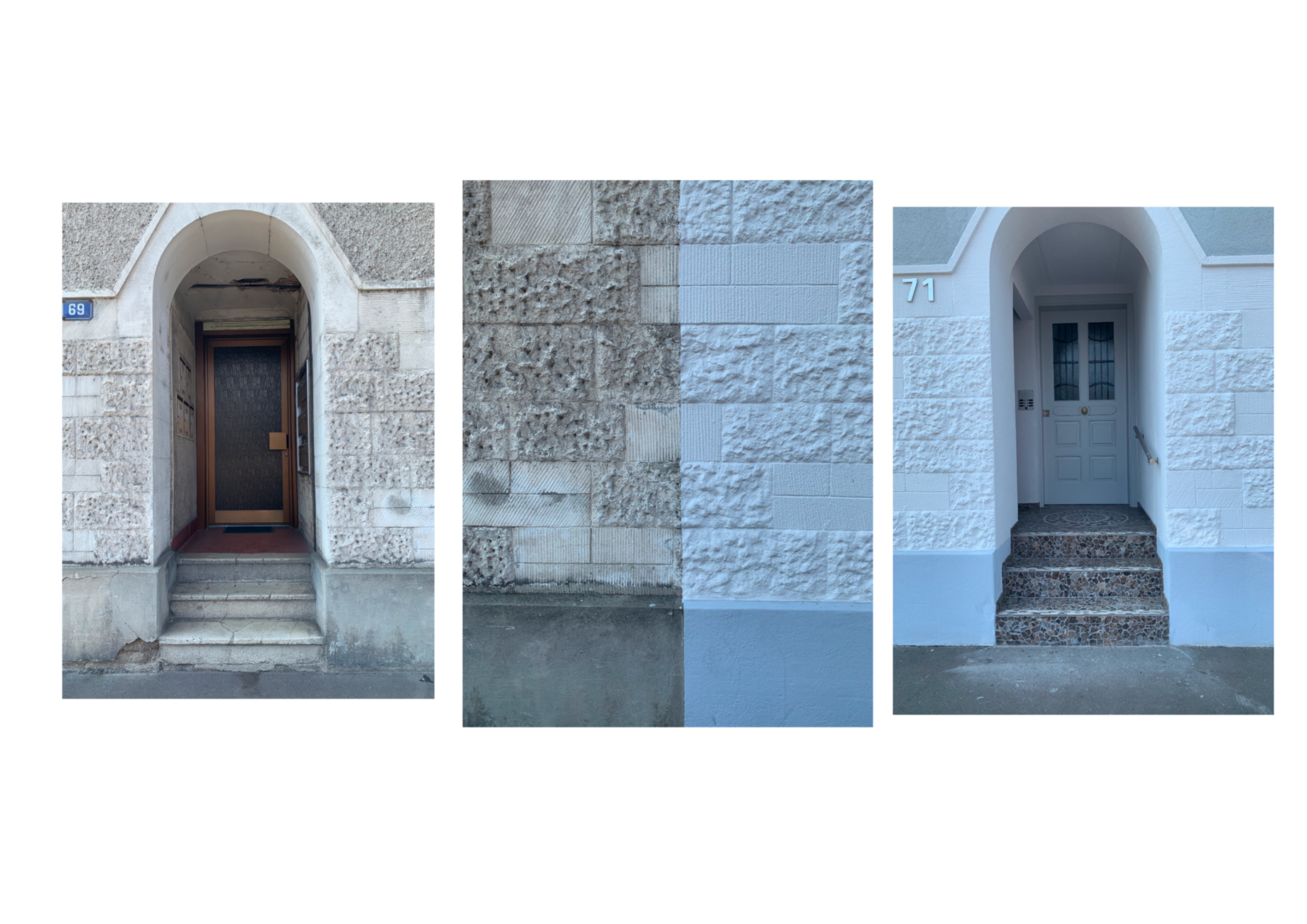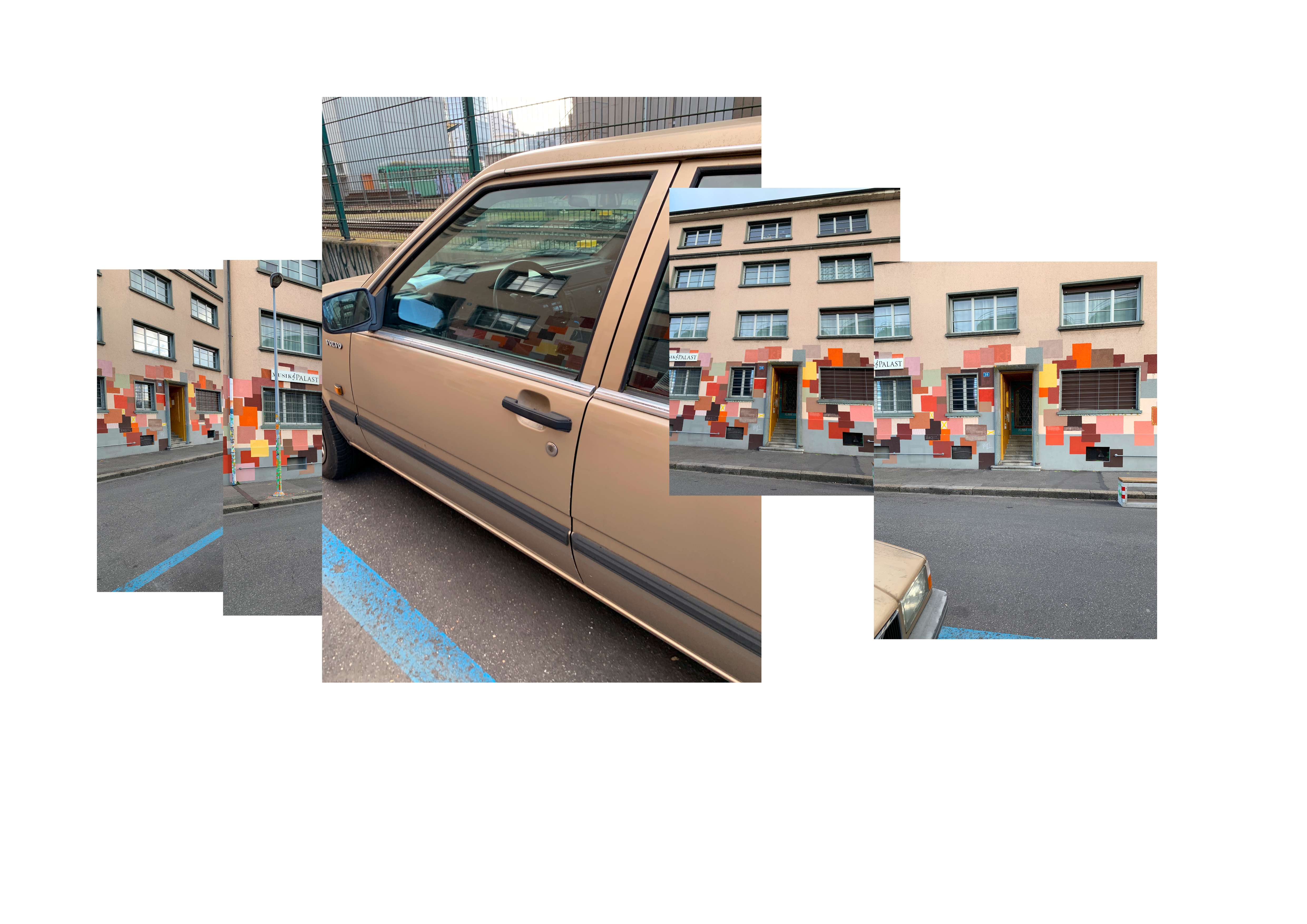Capturing the Peripheral and Multi-Perspectival
“Peripheral vision integrates us with space and its events, while
focused vision pushes us out of the space and makes us mere observers.”[1] – Juhani Pallasmaa
Experiment 2: Visualizing multiple the peripheral and perspectives
In these series of experiments, I explore visualizing the multi-perspectival characteristics of the space. Using both my photography of Klybeck as well as google map views, I used the computer to investigate multi-perspectival impressions by layering and moving the viewpoints. Recreating my visual movement around the space, physically or virtually. By attempting to keep the focus on one point, mimicking how the eye handles the peripheral vision, I was able to create an impression of the blurred and fading characteristics of urban space.








Experiment 3: Exploring perspective and repetition with collage
These series of collages started as computer explorations to visualize the sensations of rhythm and repetition that I experienced in the space. Looking at my photographs, I realized I often took similarly composed images as I walked along the façade of a building. Recognizing that these repeating elements somehow created a rhythm in my mind as I walked. These explorations are intended to show more than just the totality of the facades of the buildings as I walked but also emphasis the experience of perspective and repetition. My later experiments have moved on to paper collage, using printouts of my photos and working at a larger scale.








After looking at movement and time, characteristics which exist in our mind or bodily, this section considers visual experiences such as peripheral vision, multi-perspectival impressions or reflected and layered images. I consider here these visual sensations and how they are perceived and can be communicated.
Juhani Pallasmaa has spoken extensively about the nature of our peripheral vision and its importance in our visualization and understanding of our physical space. His passion and expertise on this subject are worth conveying, and so he will be referenced many times in the next few paragraphs. In his essay, Selfhood and the World, Vision and Hapticity, Pallismaa elaborates on the importance of peripheral view "Dynamic vagueness and absence of focus are the conditions of our normal condition of visual perception although we do not usually acknowledge it. Most of us with normal eyesight tend to believe that we see the world around us in focus at all times. This fact is that we see a blur, and only a tiny fraction of the visual field at any time - about one-thousandth of the entire field of vision - is seen distinctly."[2]
This peripheral vision according to Pallasmaa is 'read' at the same, or possibly even higher, level of importance as our focused central vision and also interestingly is a much more significant percentage of what we actually 'see.' "The pre-conscious perceptual realm, which is experienced outside the sphere focused vision is just as important existentially as the focused image. In, fact, there is medical evidence that peripheral vision has a higher priority in our perceptual and mental system."[3]
Pallasmaa's description of the nature of peripheral images could provide a basis for the formation of artistic images, as these unconsciously perceived images seem to have many dreamlike or artistic qualities. "Unconscious peripheral perception transforms sharp and fragmentary retinal images into gestalt, free and vague spatial embodied and haptic experiences that constitute our full existential and plastic experience and sense of continuity.”[4]
In this same lecture Pallasmaa quotes, modern art theorist Anton Ehrenzweig, "These case histories prove, if a proof is needed, that an over-whelming psychological need exists that requires us to have the last part of the visual field in a vague medley of images."[5]Perhaps this way of perceiving, in which we allow ourselves to slide into the awareness of peripheral images is not only biologically prescribed but also somehow leads to a new level of understanding beyond our visual awareness. Ehrenzweid famously said, "Our attempt at focusing must give way to the vacant all-embracing stare"[6]
Another aspect of our visualization of the urban space is the way we perceive and communicate perspectives and multi-perspectives. The ability to freeze and view the perspective in photography made it possible to better understand the way in which our eye perceives perspectives. Each shift or our body or movement of our eyes changes slightly the perspective. This multi-perspective view we experience while immersed in space has been described by Pallasmaa this way; “The perspectival understanding of space has further emphasized the architecture of vision. The quest to liberate the eye from its perspectival fixation has brought about the conception of multi-perspectival, simultaneous and haptic space. By its very definition, perspectival space turns us into outside observers, whereas simultaneous and haptic spaces enclose and enfold us in their embrace and turn us into insiders and participants.”[7]
The visualization of urban space and communities on social media is often focused on aesthetically pleasing facades photographed from a steady frontal view. This is obviously not an accurate representation of the actual way we confront facades which is always multi-perspectival and constantly shifting. The haptic experience of the space is lost in this type of incomplete representation, as the single fixed point of photo does not consider the multiple visual information a viewer would experience standing in front of the façade. Pallasmaa notes; “The visual image, although thought of in terms of a fixed picture, is itself a constructed fusion of fragmented and discontinuous precepts.”[8]
Finally, in a photograph of a space we can see and investigate specific detail for extended periods. The absence of the peripheral of multi-perspectival elements allows a focus not possible in the real viewing of the space “Every photographed object is merely the trace left by the disappearance of everything else. From the summit of this object exceptionally absent from the rest of the world, you have an unbeatable view of the world.”[9]
In the two following experiments I experiment with these fleeting and shifting visions of the peripheral and multi-perspectival views of the urban space.
[1] (Pallasmaa, 2011a) p.60
[2] (Pallasmaa, 2011a) p.50
[3] (Pallasmaa, 2011a) p.60
[4] Archizoom EPFL, 2016 – Transcribed from Pallasmaa’s recorded lecture ‘The Embodied Image’
[5] Archizoom EPFL, 2016 Transcribed from Pallasmaa’s recorded lecture ‘The Embodied Image’
[6] Ehrenzweig, 1967 p.67 Anton Ehrenweig is a modern art theorist
[7] Pallasmaa, 2011a p.59
[8] Pallasmaa, 2011b p.50
[9] Baudrillard, 1996 p.85